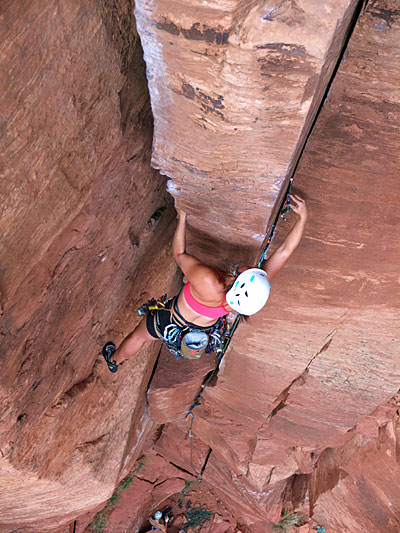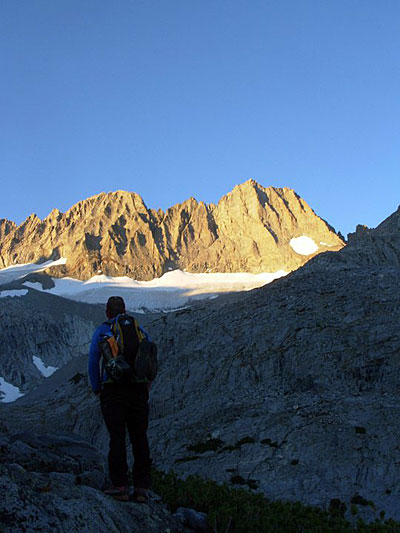5 Climbing Towns Under 1000
Yeah, I know. Boulder (or Seattle, or Salt Lake City) is the best climbing town in the US of A. Any day of the week, I could climb classics of any grade, in any discipline of the sport. The best in the world come to climb and train there, and have for the past forty years. The town is young, hip, and has great access. The thing is, I just don’t want to live in a town that big.
I have always loved the idea of a small town. I want to live in a place where “the other side of town” is a five minute walk, and I recognize everyone I see. I want to live in a place where dogs don’t need leashes, and I can ride my bike to the crag. I want to live in a place where I can hear a river at night, not ambulances and trucks. I want to live where I can pee off my front porch.
So for all of those who are like me, people who love climbing and want to live in a town smaller than most public high schools, here’s my list of the five best climbing towns with less than a thousand residents.
 #1) Springdale, Utah
#1) Springdale, Utah
Yes, I am biased on this one, because this is where I live. Springdale is the entrance to Zion National Park, home to the biggest, baddest sandstone walls in the country. The Park itself has a number of classic, moderate big walls, as well as some of the best hard multi-pitch free climbs you’ll find anywhere. The town is also only an hour away from high quality limestone sport climbing around St. George. What ultimately won me over, though, is the amount of unclimbed rock here. There are miles of untouched cliffs, both short and tall, waiting for the intrepid first ascentionist.
Notable Crags: Zion National Park, The Virgin River Gorge, Snow Canyon State Park, The Hurricave, various other limestone crags near St. George.
Worthwhile distractions: Deep Creek Coffee, The Bit ‘n’ Spur Saloon, Café Soleil, Zion Mountain School.
#2) Ouray, Colorado
Ouray is best known for the Ouray Ice Park, possibly the best place on earth to learn to ice climb, but in addition to the farmed ice, the surrounding mountain passes hold a huge array of ice and mixed lines, from fun moderates to modern test pieces. In the summer, climbers can head to any number of small local crags, drive a couple hours to desert sandstone, or get their alpine fix in the surrounding San Juan Mountains. There are few things better than ending a long day of climbing with a soak in the hot springs, provided by the Ouray municipal pool.
Notable crags: Ouray Ice Park, Camp Bird Road, Red Mountain Pass, Eureka, Pool Wall, Ophir Wall.
Worthwhile distractions: Ouray hot springs, Mouse’s Chocolates, Ouray Brewery, Ourayle House, Ouray Mountain Sports.
 #3) Lee Vining, California
#3) Lee Vining, California
If you’ve ever driven to Yosemite from the east, you passed through Lee Vining. The town sits at the bottom of Tioga pass, the northeast entrance to Yosemite National Park, where Tuolumne Meadows is. Add the access to the High Sierra peaks, winter ice climbing, and the local welded tuff crags, and the Lee Vining area starts to look like the best little climbing town in California. Although the town is pretty sleepy, there is four star food and five star parties at the local Mobil station, where the east side and Yosemite crowds meet and dance to bluegrass shows in the summer.
Notable crags: Yosemite Valley and Tuolumne Meadows, Lee Vining Canyon, Dana Plateau, June Lake Boulders, Mammoth Lakes area cragging.
Worthwhile distractions: The Whoa Nellie Deli (in the Mobil station, music in the summer), Mono Lake.
#4) Mazama, Washington
The residents of this small town on the east side of the Cascades, named it after what they thought was the Greek name for “mountain goat.” It turned out that they were looking in the wrong dictionary; “Mazama” means mountain goat in Spanish, not Greek. Still, it is an apt name for the town, as it sits just below Washington Pass in the North Cascades. In addition to the roadside alpine rock and access to some of the best alpine lines in the lower 48, there is great cragging in the summer on several different rock types, and backcountry skiing in the winter. Mazama is truly a small rural town; there is no chain store or stop lights for 70 miles.
Notable areas: Washington Pass, Fun rock, Goat Wall, Gate Creek, Prospector area
Worthwhile distractions: Goat’s Beard, The Mazama Store, Old School House Brewery, Kelly’s at Wesola Polana, North Cascades Adventure Hostel.
#5) Ten Sleep, Wyoming
The only people who know of Ten Sleep are bikers, cowboys, and climbers. It’s also the only town where you’ll meet someone who fits into all three categories. If you drive east on Highway 16 into the Big Horn Mountains, you’ll find yourself gawking at the miles of cliffs in Ten Sleep Canyon, home to some of America’s best limestone sport climbing. The climbing is usually long, vertical, and very technical. The high alpine setting makes it a great area for the summer months, and in the winter there is backcountry ice to explore. There are also huge granite and gneiss walls deep in the Cloud Peaks Wilderness area, home to long, obscure adventure routes.
Notable Areas: Ten Sleep Canyon, Cloud Peaks Wilderness Area, various limestone canyons and spires in the Big Horn Mountains.
Worthwhile distractions: Dirty Sally’s, Ten Sleep Saloon, The Paintrock Inn.
I’m sure there are more out there, perhaps in New Hampshire, or deep in the southeast? More suggestions are appreciated!
Ethan Newman is a climber and writer based in Springdale, Utah. This is his first article for SplitterChoss.com.
12 Responses to 5 Climbing Towns Under 1000
Bulldog Creek Dog Walk (IV WI 4+)
Hayden Carpenter and Tom Bohanon recently repeated an obscure ice climb on the south side of Mt Sopris. Given a brief mention in Jack Robert’s ice guide, Bulldog Creek Walk is described as being 100 meters of WI 4. What they found was seven pitches of ice in a remote setting that makes for one […]
Connect with Us















Would love to see a list for slightly bigger towns, like from 1000 to 10,000 residents. And never let your town’s population give you stage fright, keep the river flowing.
In Mazama you not only have the North Cascades at your doorstep, but you’re less then 5 hours away from Squamish, 3 hours to sport climbing in Shaka, and a day’s drive to the Bugaboos or Banff. It’s a great place to be.
As to your question about New Hampshire towns, Jackson and Rumney are probably the top two. Jackson is minutes away from Cathedral and Whitehorse Ledges for long trad lines and some ice climbing, and just down the road from Mt Washington’s Huntington Ravine which is definitely one of the scariest, burliest places for ice climbing on the East coast. Rumney, not much has to be said. But in addition to all the sport climbing, it’s about half an hour from Cannon Cliff which is big, scary, and awesome.
Great list. Way better than the rehashed lists that come out every week in Outside or any other major magazine you care to mention.
How about Keene Valley in the Adirondacks. My guidebook is huge for the daks, there’s classics everywhere and you can go cragging or do long lines or aid climb or sport climb or boulder. The ice is phenomenal and a ton is super close to the road. I can have a cliff all to myself in the daks even on the busiest weekends because there is literally just so many climbs. If you’re feeling venturous also the gunks is only 4 hours away which isn’t too bad for a weekend trip. People forget the east coast exits and how vast some of it is.
Good call on that one Dominic, I love the climbing in the Adirondacks. Most East Coast climbing, like the Gunks, is really close to big cities and really crowded, but the Daks are definitely an exception to that.
+1 on Keene Valley
I grew up in AuSable Forks and give your suggestion 2 thumbs down. Great place to grow up. I live in the Bitterroot Valley, Hamilton Montana. There is no comparison to the west, every sport is better!
4 star? FOUR STAR? Oh, the blasphemy.
Great article (with that one exception of course)!
Thanks for the info on great east coast climbing towns, Matt and Dominic. I really haven’t climbed up there enough to know the spots, but then again, I guess that is why they’re small!
And Ryan, in my book the Whoa Nelly Deli is six stars, but four is what they claim.
Jasper, Arkansas. Little town of 466 people in the Ozarks. Great sandstone all around the area, albeit almost all single pitch. Great sport climbing and bouldering just 15 minutes away at Horseshoe Canyon Ranch (home of the 24 Hours of Horseshoe Hell). 30 minutes to the Sam’s Throne area, with loads of trad climbs. The area also holds some sport climbing gems at Cave Creek, Candy Mountain, and Valley of the Blind. Stack Rock is maybe an hour or so away. New crags still being developed, and plenty of smaller ones I am not listing here. With the occasional exception of a few areas at Horseshoe, there is pretty much no one out there. You have the Ozark Cafe in the sleepy town. The Buffalo River is there, too, with loads of hiking and fishing (and some deep-water bouldering on limestone at times, too). Summers can be hot and muggy, but you can climb year-round. As long as you like single-pitch sandstone, Jasper is an awesome little place that few people know about.
I like the picture of Middle Palisade for Lee Vining. Too bad that peak would be most closely associated with Big Pine, CA. Not exactly a town associated with a strong climbing culture.
i’d throw hill city, south dakota into the mix, as well. it’s minutes from black hills granite crags (mt. baldy, cathedral spires, sylvan lake, etc…at least 1,000 lines to choose from) and under an hour drive from spearfish (500+ sport lines) and victoria canyon (50+ super steep, Arsenal-style sport lines), as well as other lesser known crags. you’re also only a 2.5 hour drive from devils and tower and 4.5 hours from tensleep.